- V
- GF
- NS
- DF
- View Recipe Key
How to Make Pissaladière: Provençal Onion and Anchovy Flatbread (VIDEO)
How to Make Pissaladière: Provençal Onion and Anchovy Flatbread (VIDEO)
Pissaladière is a flavorful Provençal flatbread garnished with caramelized onions, olives, and anchovies. Learn how to make this classic French dish, perfect for happy hour, lunch, or a picnic!
If you’ve been following me for a while, you know all about my love for l’apéro. “L’apéro” is short for l’apéritif, which is the name of a drink served in the early evening to whet your appetite. In French cities, people have l’apéro in restaurants and bars, where servers bring salty snacks to go with the drinks. But this tradition of getting together after work to relax with a drink before dinner is also a full-blown ritual that is often hosted at home, accompanied by a variety of bites or appetizers that can become generous enough to act as dinner itself.
L’apéro is in my blood: all through my childhood, I watched my parents host it. Even when my mother hosted a sit-down dinner, she always first gathered guests in the living room for l’apéro. As an adult, I’ve kept this tradition going. To me, l’apéro is more than an after-work ritual: it’s how I keep connected with friends. All of the get-togethers I participate in with friends and family start with a drink and some nibbles—i.e., l’apéro.
On most nights, l’apéro is a casual affair: I’ll simply serve olives, mixed nuts, sliced veggies, a dip (most often store-bought), and some chips.
On weekends when I have more time on my hands or on celebratory nights, I like to add special homemade bites that give the occasion a more festive feel. Savory madeleines, French savory cake, fried olives, and cheese straws are some of my go-to recipes—not only because they’re delicious, but because my friends keep requesting them!
Pissaladière has also become a favorite of mine, and my guests too. Everybody loves flatbread, especially one that’s crunchy and garnished with irresistible toppings. Pissaladière checks all those boxes—and it’s not even hard to make. All you need is a bit of time on your hands to prepare the main elements in advance, then you simply assemble the tart a short time before your guests arrive, bake, slice, and enjoy with a glass of rosé!
How to Make Pissaladière: RECIPE VIDEO
What is Pissaladière?
Pissaladière is a type of flatbread. Although it is widely associated with Nice, a city in Provence, in the South of France, pissaladière was actually first created in Linguria, in Italy, a province that shares a border with France. In Italy, the dish was called pissalandrea and was considered a type of pizza garnished with onions, anchovies, and olive oil. The popularity of the dish eventually reached France, where small black olives were added to the toppings.
Pissaladière is made with a bread-like dough that is stretched and garnished with caramelized onions, anchovies, and small Niçoise black olives. You can eat pissaladière warm or at room temperature.
The provençal flatbread got its French name from pissalat, a condiment that was traditionally used as a topping for pissaladière. Pissalat was made “by layering baby anchovies and sardines with salt, spices, and herbs, then fermenting the mixture for 45 days before pressing through a sieve to remove the tiny bones.” (Source: Saveur Magazine) The condiment is much less common these days, and using whole anchovy fillets to garnish pissaladière has become the norm.
How do you pronounce Pissaladière?
Pissaladière can seem like quite the tongue-twister for English speakers, but it’s not that hard to say. The trickiest part of the word is the last syllable—“dière”—in which the “i” sounds like a “y.” Imagine saying “dyou,” with the “d” sliding into the “you.” It’s the same in pissaladière, but the syllable sounds more like “dyer,” which you shouldn’t pronounce “die-her” but “d-yer,” with the “e” open, as in the word “bet.”
Therefore, pissaladière is pronounced pi – sa – la – d-YER (remember to pronounce that “e” in “yer” as you would in “bet”). You can listen to a French person pronouncing the word—click on the red speaker icon to the left of the word to hear it—and practice saying it out loud. Soon enough you’ll impress your friends while serving the dish with your perfect diction!
What’s on a Pissaladière?
Traditional pissaladière has an iconic look: anchovies are placed in a criss-crossing pattern on top of the baked tart, with niçoise olives set precisely on every point where the anchovies cross paths. This makes for a pretty presentation, but since anchovies are very salty, if you eat one in a single bite, the flavor can be a bit overwhelming.
My modern take on pissaladière is actually closer to the original recipe in that I use an anchovy condiment as a topping instead of setting whole anchovy fillets over the tart. I started doing that several years ago after noticing the whole anchovy fillets intimidated some of my guests. Many were quick to say, “I hate anchovies!” without even giving the tart a bite. I decided to make anchoïade and slather the dough with it, instead. The dressing provides the same salty, intriguingly umami-filled flavor, without the fishy look.
Anchoïade is made with anchovies, olive oil, red wine vinegar, capers, and garlic, making it extremely rich in flavor, yet fresh and aromatic. This sauce, or dressing, is traditionally used as a dip for crudités in France, but I also use it to dress pasta—and top pissaladière too. Since I made this change to my recipe, I’ve never heard complaints about anchovies again, only “aahs” and “yums” as my guests devour the tart.
As a finishing touch, I also like to add a generous amount of fresh herbs. It makes the provençal flatbread especially beautiful and adds a lot of fresh flavors, too!
What type of onions should I use to make pissaladière?
You can use good old yellow onions to caramelize and use as topping on the Provençal flatbread. I like to use red onions for their color, but since the color fades quite a bit once cooked and the flavor is very similar to that of yellow onions, you can use whatever variety you have on hand.
What type of anchovies should I use to make pissaladière?
Use anchovy fillets that are packed in oil, and buy the best quality you can afford. I recommend buying anchovies sold in a glass jar, as opposed to those sold in a tin can. An opened jar of anchovies keeps almost indefinitely at the back of the refrigerator. If you can only find tinned anchovies, transfer the leftovers with their packing oil in a small airtight jar to keep refrigerated until you need some again.
What type of olives should I use on pissaladière?
The classic type of olives used on the Provençal flatbread is Niçoise olives. Niçoise olives are tiny black olives that are sold back in brine or olive oil. I recommend using those packed in olive oil because they’re slightly less salty.
Olives are sometimes used whole on pissaladière, meaning the pit is still in. While this is traditional, I find it quite annoying to bite into a piece of flatbread and then have to wrestle with an olive pit instead of really enjoying the dish. If you can find them, I highly recommend using pitted Niçoise olives, or you can pit them yourself. Pitted olives make pissaladière much easier to eat.
If you can’t find Niçoise olives, you can look for Italian Taggiasche olives, which are the same variety as Niçoises, so the flavor is the same. If you can’t find either variety, you can substitute Kalamata olives, which have a slightly different flavor, but are easy to find in pitted form.
Can pissaladière be made ahead of time?
Pissaladière is at its very best when freshly baked, or recently out of the oven (less than a couple of hours ago).You can do most of the work ahead of time, though: make the dough, the caramelized onions, and the anchoïade the day before, then assemble and bake the provençal flatbread shortly before serving.
If you don’t have time to bake pissaladière on the day you plan on serving it, you can bake it the day before, let it cool completely, cover with plastic wrap, then refrigerate. Return to a 325°F (160°C) oven for 10 minutes before serving to give it that “fresh out of the oven” texture and flavor, then garnish with the black olives and fresh herbs just before serving.
How to Make Pissaladière, Step-by-Step
1. Make the dough: In a large bowl, stir together the yeast, sugar, and water. Let sit until foamy, about 10 minutes. (Refer to the full recipe, below, for stand mixer instructions.)
2. Stir in the oil and salt. Add the flour and mix until the ingredients come together in a craggy ball of dough.
3. Transfer to a lightly floured surface. Knead for 10 minutes, turning it and folding it repeatedly, until the dough feels smooth to the touch. (Watch the video to see how to properly knead the dough.)
4. Transfer to a large, lightly oiled bowl, cover with plastic wrap, and let sit in a warm, non-drafty place until doubled in size, about 1 1/2 hours.
5. Make the caramelized onions: While the dough rises, set a large pot over medium heat, add the butter and oil, and stir until the butter is melted. Add the sliced onions, sprinkle with the salt and some black pepper; stir to coat the onions with the oil and butter mixture. Reduce the heat to low, cover, and cook, stirring from time to time, until the onions are very soft and starting to caramelize, about 25 minutes. Uncover and cook for 2–3 minutes more to evaporate any leftover liquids. Transfer to a bowl to cool.
6. Make the anchoïade: In a small bowl, add all the dressing ingredients. Mash with a fork and stir to combine. Set aside.
7. Assemble the pissaladière: Generously grease an 18 x 13-in (45 x 33 cm) baking sheet (half sheet pan) with oil. Transfer the dough onto the sheet. Using your fingers, gently press the dough into the sheet, stretching it until it completely covers the baking sheet.
8. Cover with plastic wrap and let the dough rise until almost doubled in size, about 1 hour more.
Pissaladière dough, before the second rise:
Pissaladière dough, after the second rise:
9. Preheat the oven to 500°F (250°C) for at least 30 minutes (the oven needs to be very hot). Uncover the dough. Create indentations all over by pressing the tip of your fingers into the dough.
10. Drizzle the dough with extra virgin olive oil.
11. Spoon the anchoïade all over the surface of the dough, then spread it using the back of the spoon to over the whole surface.
12. Scatter the caramelized onions over the dough, leaving a 1-in (2 cm) border all around.
13. Bake until the pissaladière is golden brown around the edges, 20 to 25 minutes. Remove from the oven and let cool slightly, about 10 minutes.
14. Scatter with the olives and some fresh herbs. Serve immediately, or within the hour.
Enjoy!

Pissaladière
Ingredients
For the Dough
- 1 tsp active dry yeast
- 1 tsp granulated sugar
- 1 ¼ cups water, warm (about 115°F / 45°C)
- ¼ cup extra-virgin olive oil
- 1 tsp kosher salt, or fine sea salt
- 3 ½ cups all-purpose flour, plus more as needed
For the Caramelized Onions
- 1 tbsp extra-virgin olive oil, plus more for drizzling
- 1 tbsp butter
- 2 lbs onions (red or yellow), peeled, halved, and thinly sliced
- 1 tsp kosher salt, or fine sea salt
- Freshly ground black pepper, to taste
For the Anchoïade
- 6 anchovy fillets, mashed with a fork or very finely chopped
- ¼ cup extra-virgin olive oil
- 1 tbsp capers, drained and finely chopped
- 1 clove garlic, grated with a Microplate or very finely chopped
To Serve
- ½ cup Niçoise olives, preferably packed in oil, pitted or not (see note)
- 1 handful of fresh herb leaves (a combination or basil, oregano, marjoram and/or flat-leaf parsley, optional)
Instructions
- For the dough, STAND MIXER METHOD: In the bowl of a stand mixer, add the yeast, sugar, and water, and mix using a fork just to combine. Let sit until foamy, about 10 minutes. Mix in the oil and salt. Add half of the flour and use a fork just to combine. Add the remaining flour, attach the dough hook to the mixer, and knead at medium-low speed for 8 to 10 minutes. Stop the mixer from time to time to scrape down the hook and the bowl. If the dough is very sticky and keeps creeping up the hook, add a bit of flour, 1 tbsp (15 g) at a time, until the dough stops sticking so much. (You shouldn’t need to add more than ¼ cup / 30 g additional flour.)
- By the end of the kneading process, the dough should come together in a ball and feel smooth to the touch. Transfer to a large, lightly oiled bowl, cover with plastic wrap, and let sit in a warm, non-drafty place until doubled in size, about 1 ½ hours.
- For the dough, HAND METHOD: In a large bowl, stir together the yeast, sugar, and water. Let sit until foamy, about 10 minutes. Stir in the oil and salt. Add the flour and mix until the ingredients come together in a craggy ball of dough. Transfer to a lightly floured surface. Knead for 10 minutes, or until the dough feels smooth to the touch. If the dough is very sticky, add a bit of flour, 1 tbsp (15 g) at a time, until the dough stops sticking. (You shouldn’t need to add more than ¼ cup / 30 g additional flour.) Transfer to a large, lightly oiled bowl, cover with plastic wrap, and let sit in a warm, non-drafty place until doubled in size, about 1 ½ hours.
- For the caramelized onions: While the dough rises, set a large saute pan over medium heat, add the butter and oil, and stir until the butter is melted. Add the sliced onions, sprinkle with the salt and some black pepper; stir to coat the onions with the oil and butter mixture. Reduce the heat to low, cover, and cook, stirring from time to time, until the onions are very soft and starting to caramelize, about 25 minutes. Uncover and cook for 2–3 minutes more to evaporate any leftover liquids. Transfer to a bowl to cool.
- For the anchoïade: In a small bowl, add all the dressing ingredients. Stir to combine. Set aside.
- To bake: Generously grease an 18 x 13-in (45 x 33 cm) baking sheet (half sheet pan) with oil. Transfer the dough onto the sheet. Using your fingers, gently press the dough into the sheet, stretching it until it completely covers the baking sheet. Cover with plastic wrap and let the dough rise until almost doubled in size, about 1 hour more.
- Preheat the oven to 500°F (260°C) for at least 30 minutes (the oven needs to be very hot). Uncover the dough. Create indentations all over by pressing the tip of your fingers into the dough. Brush the whole surface (right up to the edges) with the dressing. Scatter the caramelized onions over the dough, leaving a 1-in (2 cm) border all around. Bake until the pissaladière is golden brown around the edges, 20 to 25 minutes.
- Remove from the oven and let cool slightly, about 10 minutes.
- SERVING: Scatter with the olives and some fresh herbs. Serve immediately.
- STORAGE: You can prepare the pissaladière up to a day in advance. Let it cool completely to room temperature, then cover with plastic wrap. Refrigerate. Warm up in a 350°F (175°C) oven for 8 to 10 minutes, then garnish with olives and herbs right before serving.
- NOTES: Pissaladière is traditionally garnished with whole olives, but I find it difficult to truly enjoy the dish when you need to manage olive pits. I prefer using pitted olives, and I strongly recommend using olives packed in olive oil because these have a smoother flavor than the ones packed in brine.If you can’t find Niçoise olives, you can use Italian Taggiasche or Greek Kalamata olives instead.
Did you make this?
Tell me how you liked it! Leave a comment or take a picture and tag it with @foodnouveau on Instagram.
Author: Marie Asselin


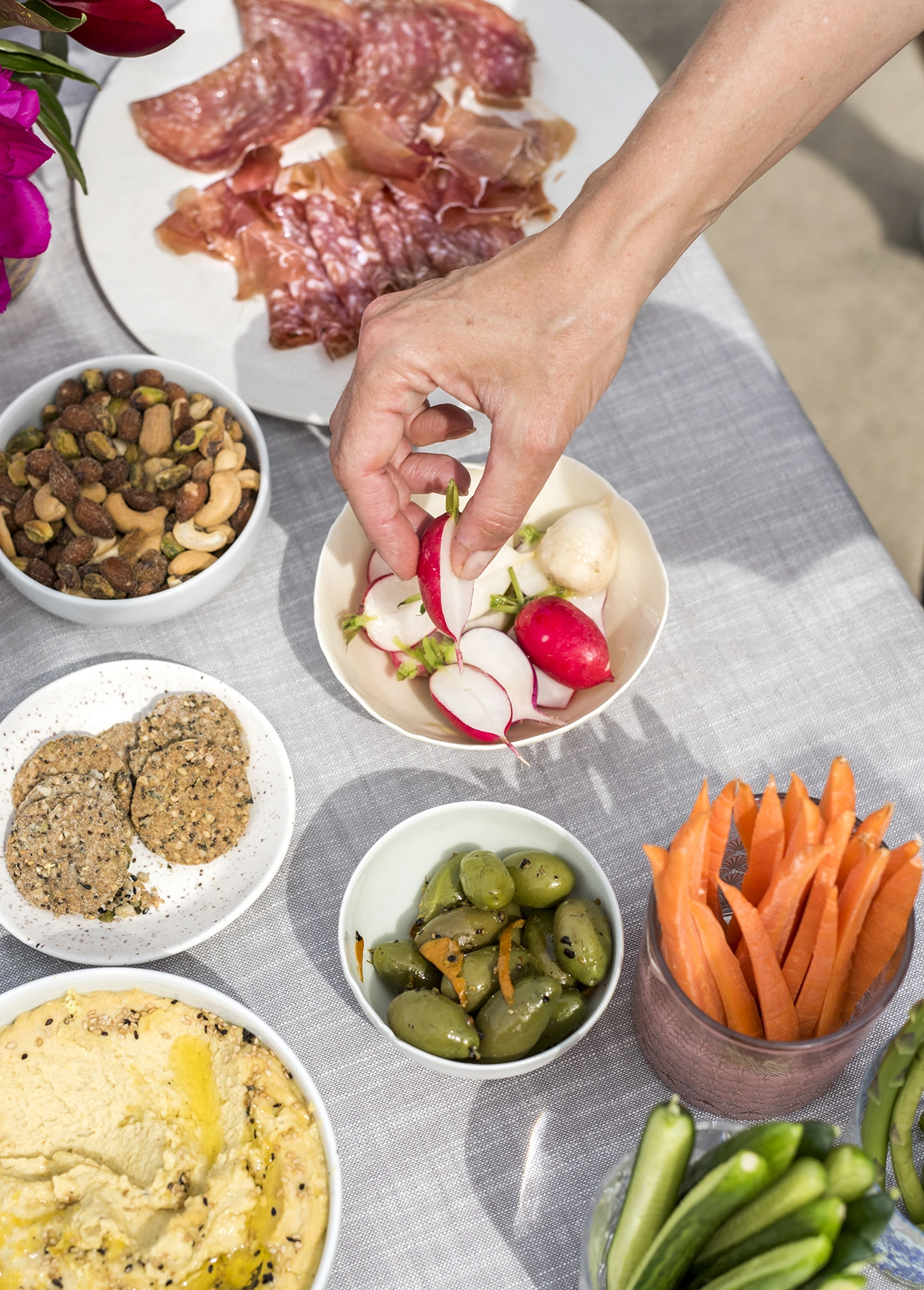
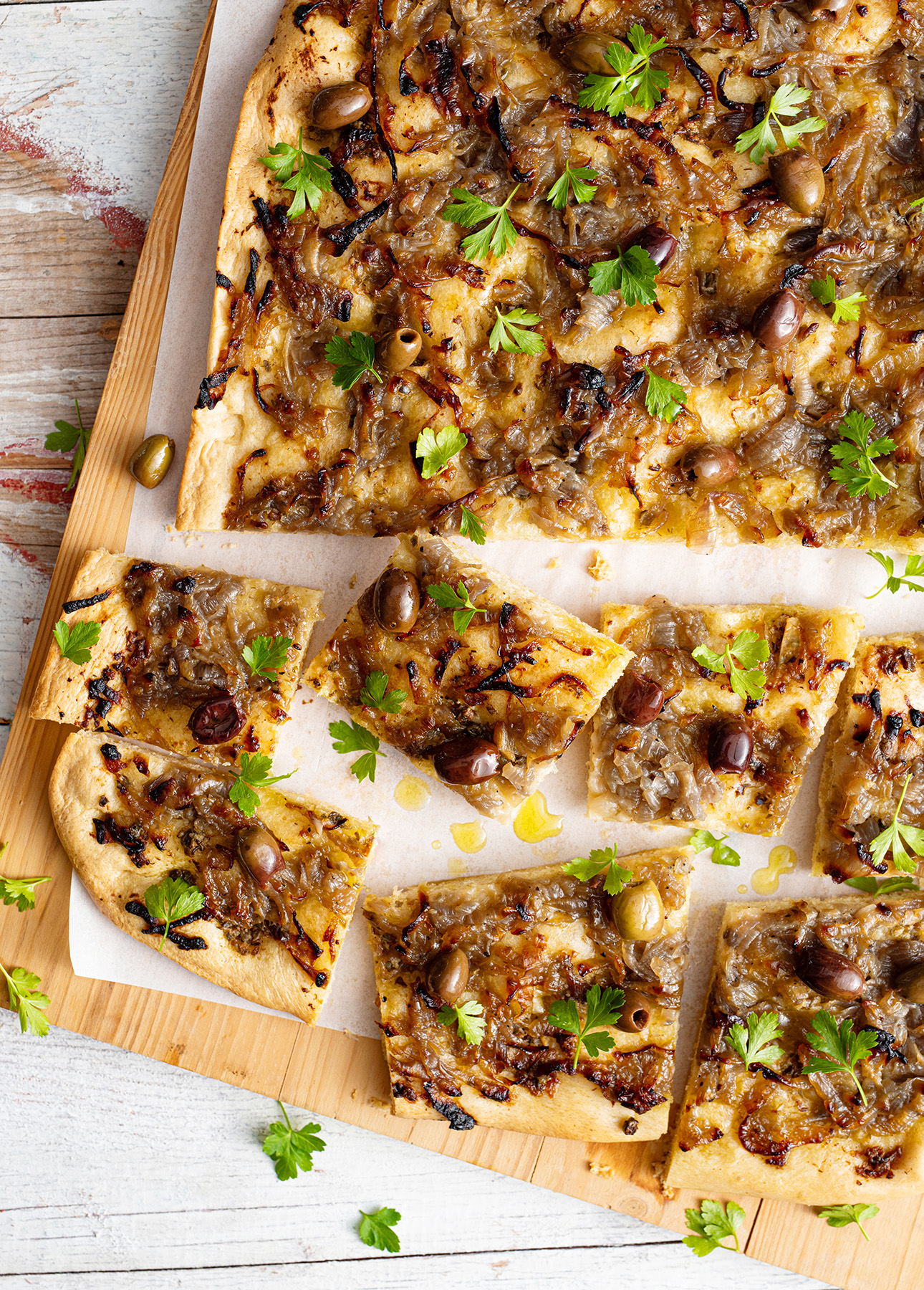
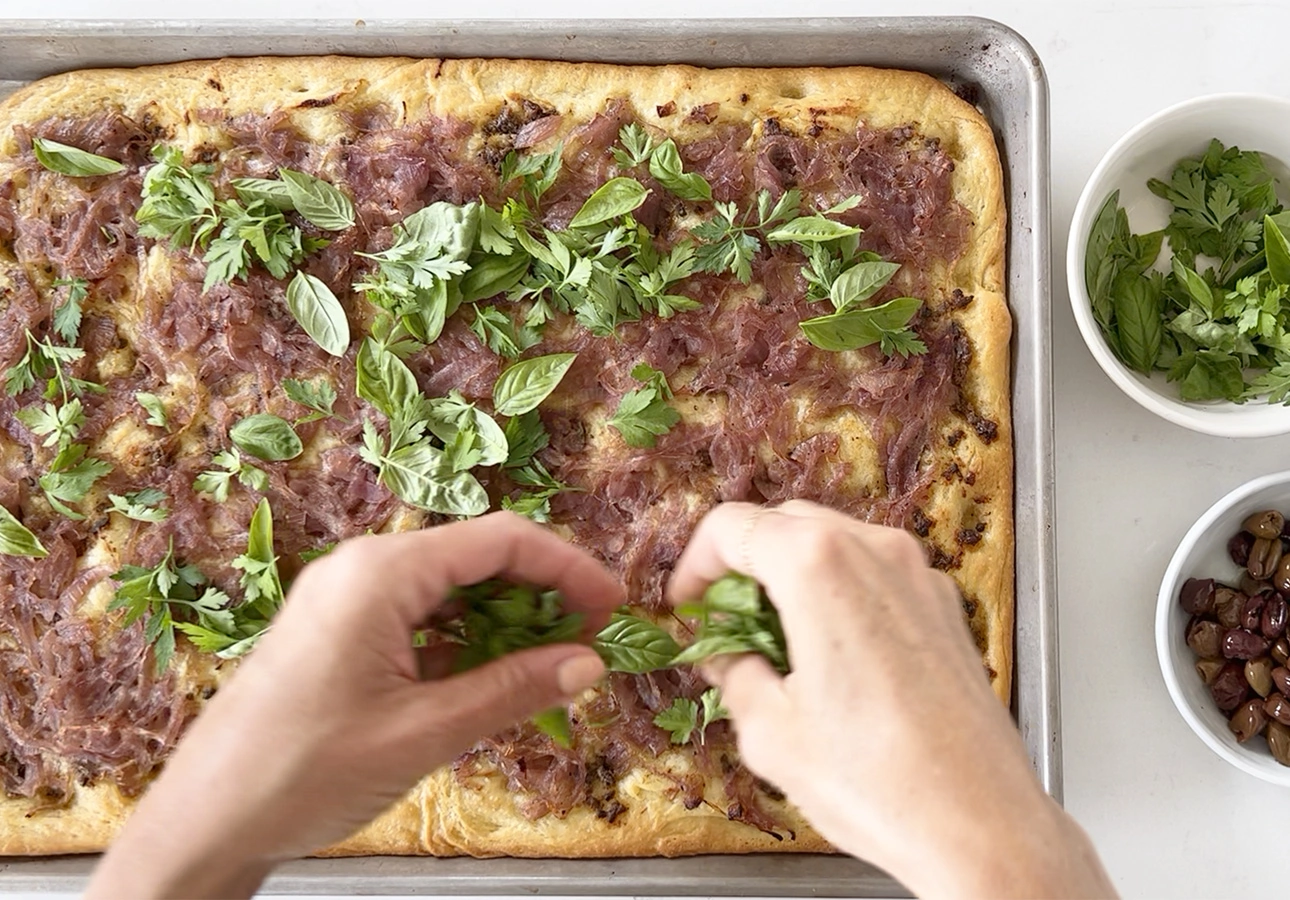

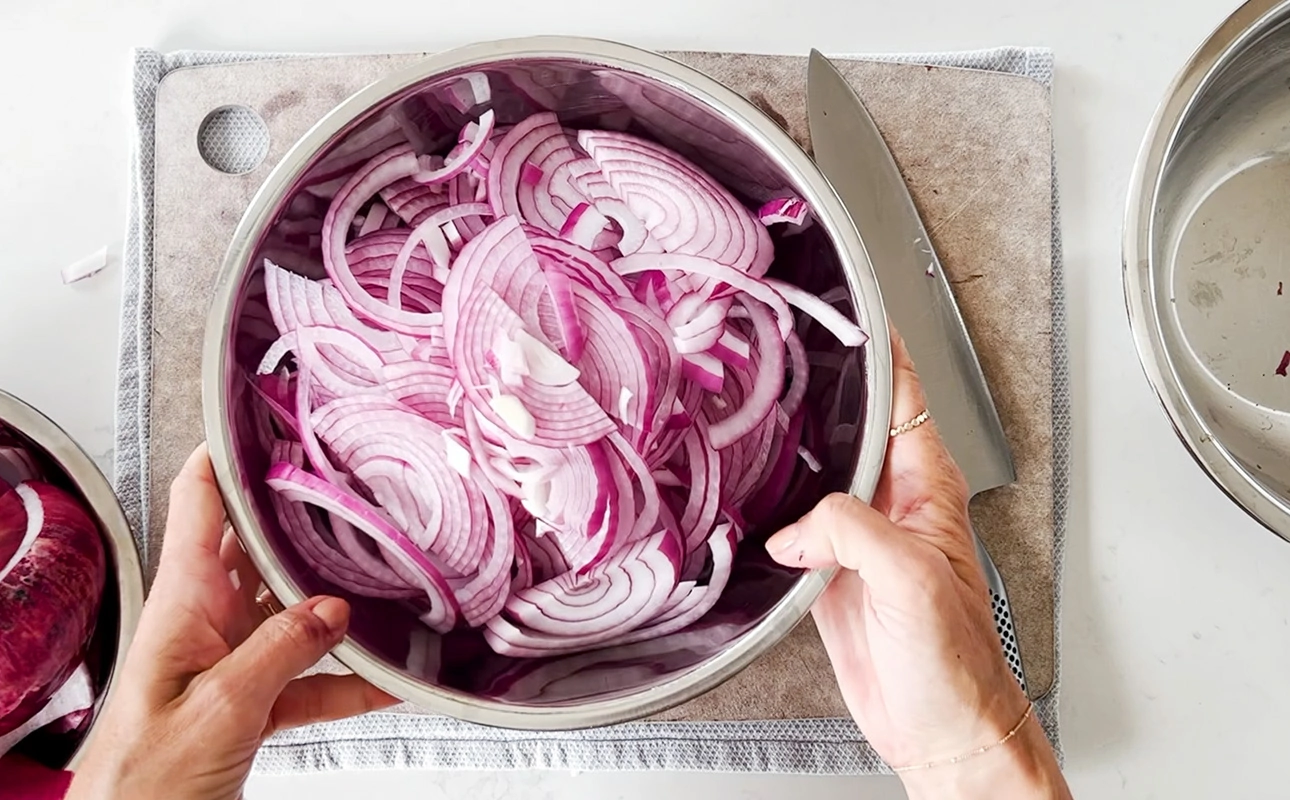
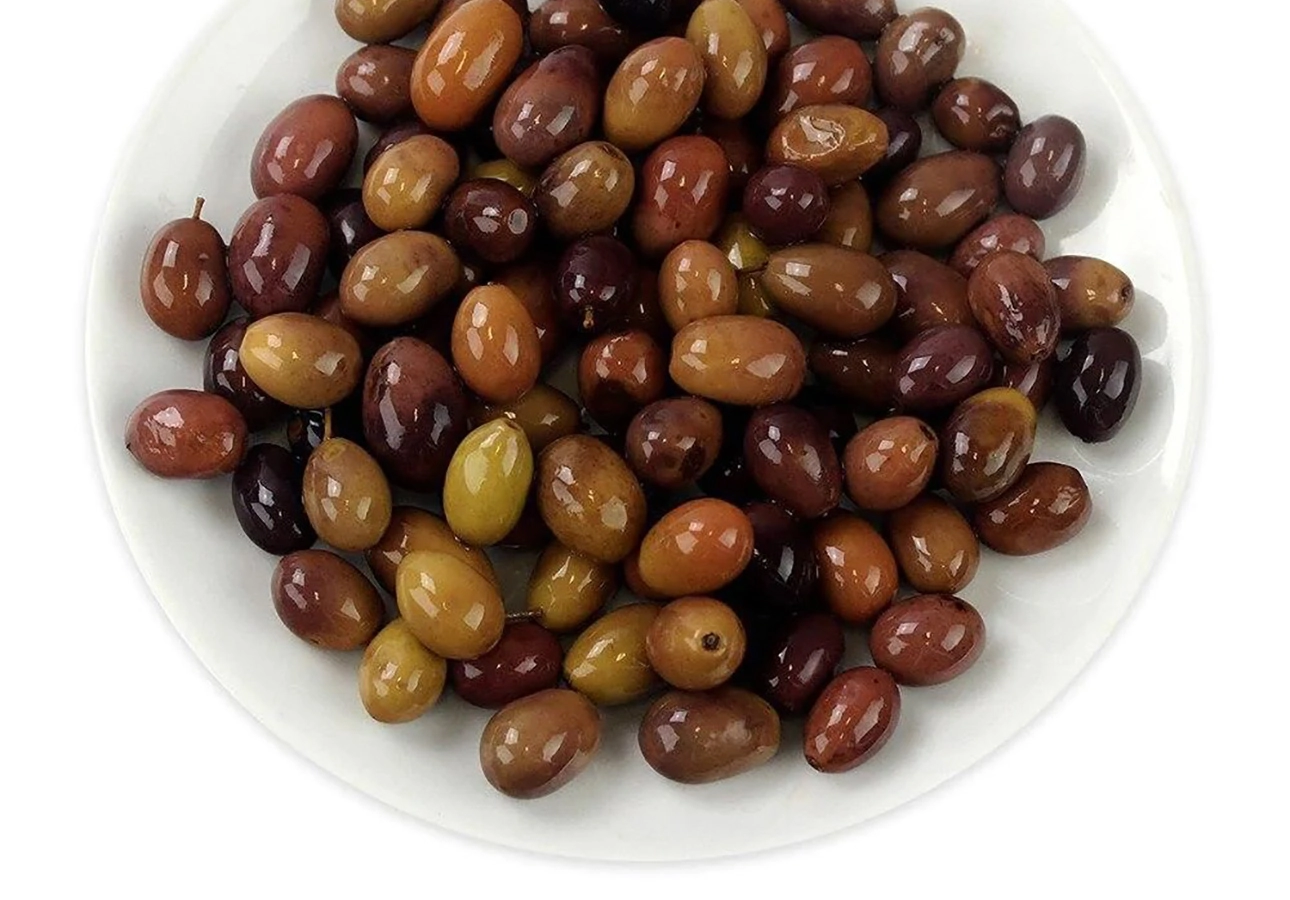
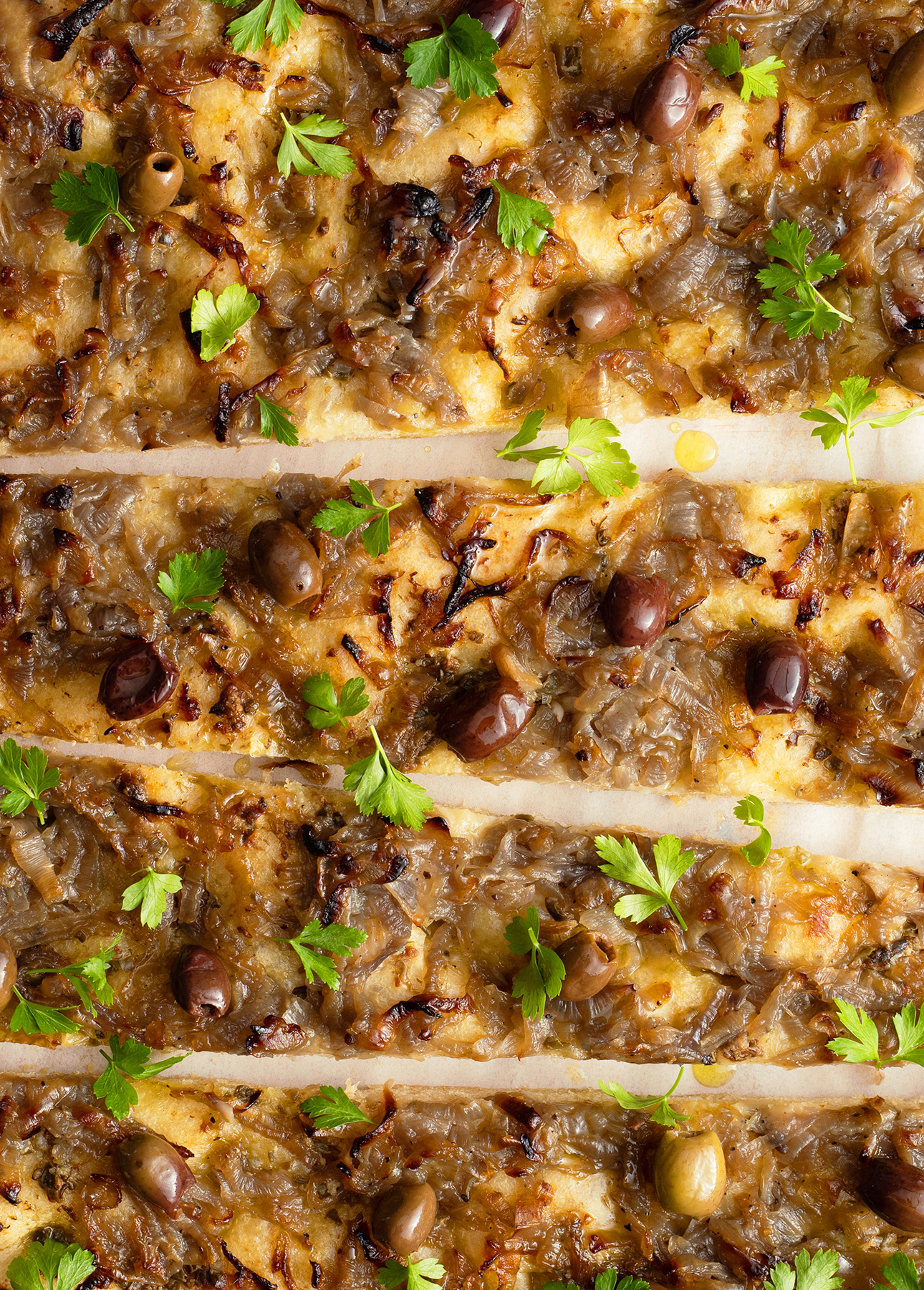
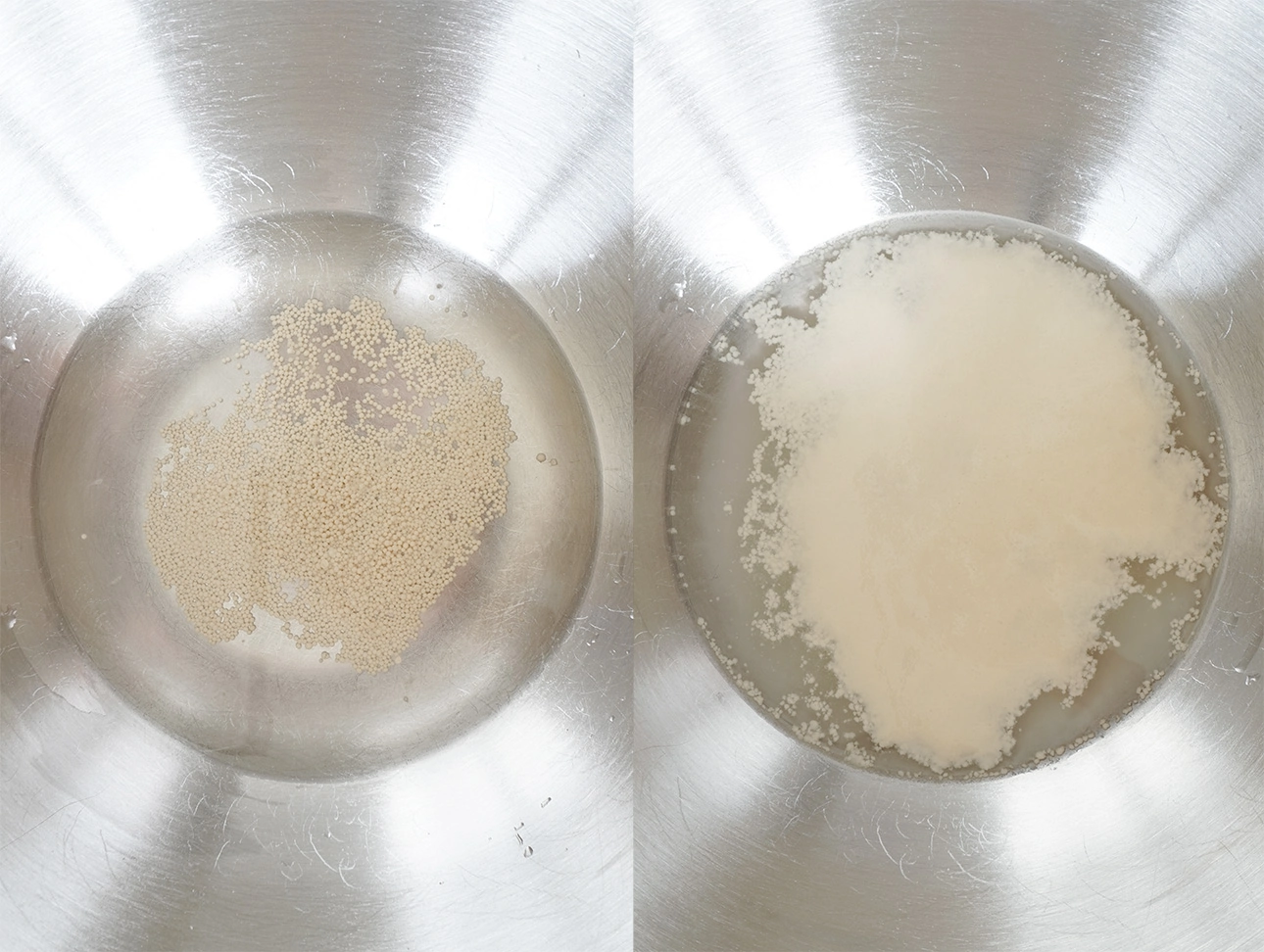
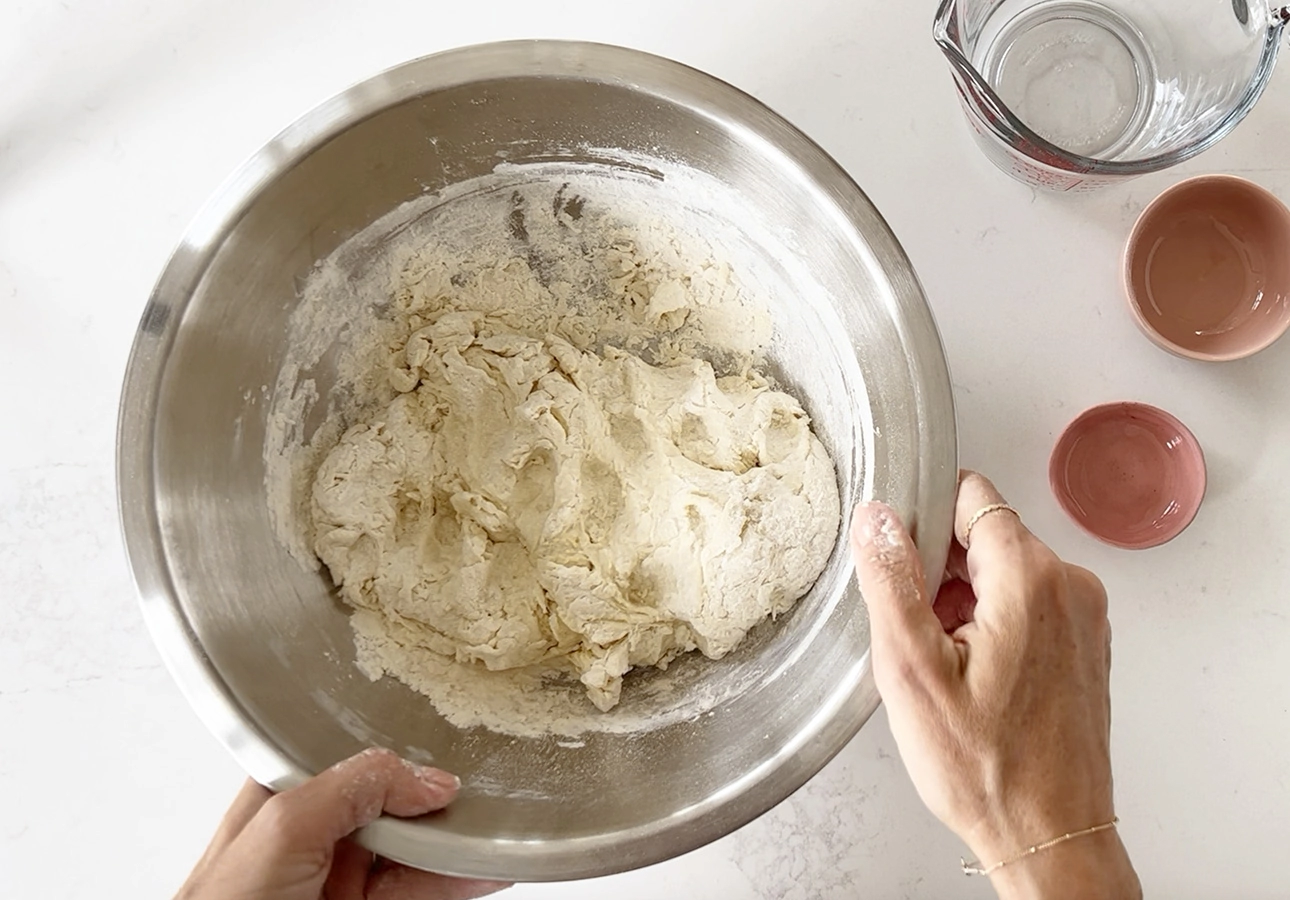
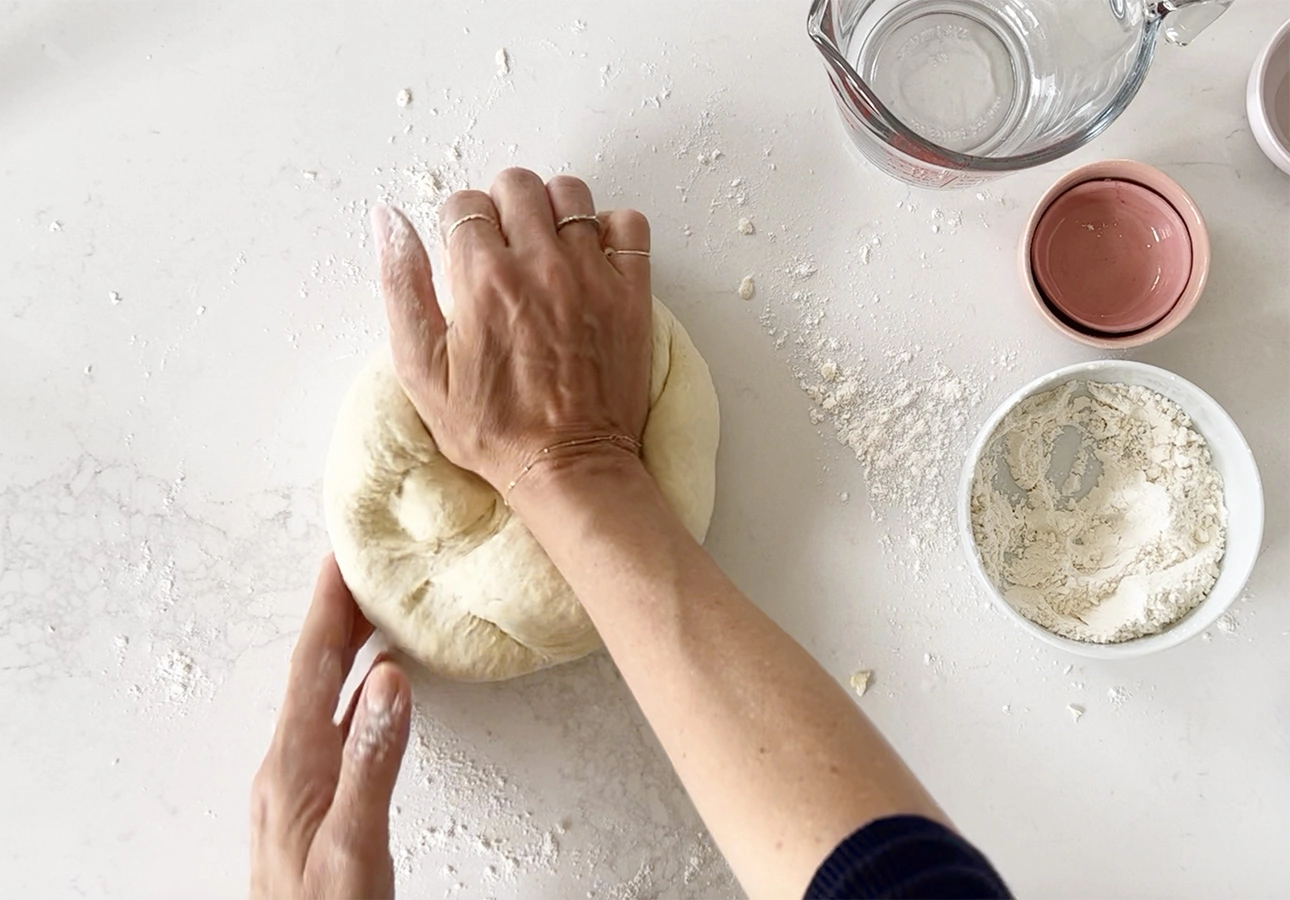
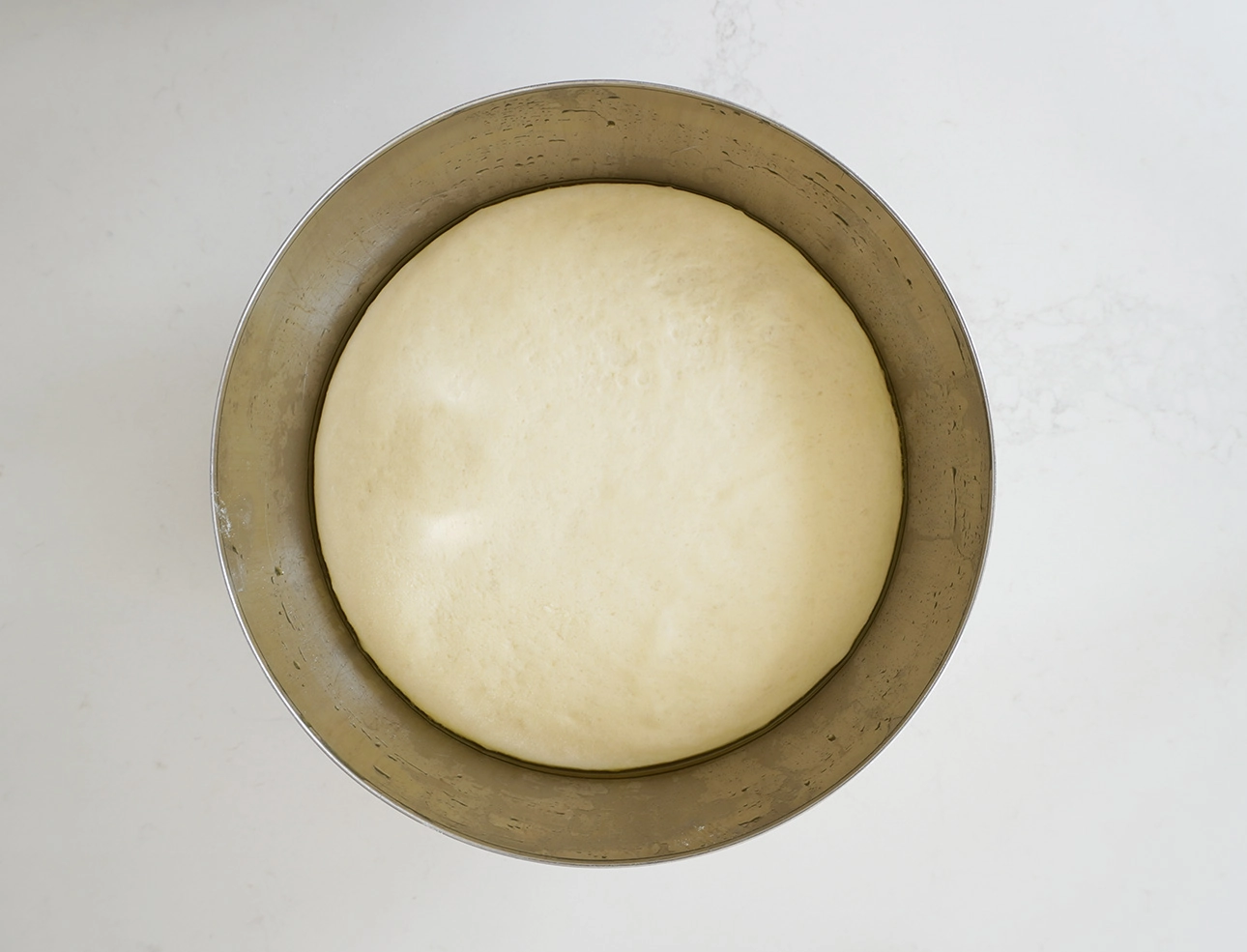
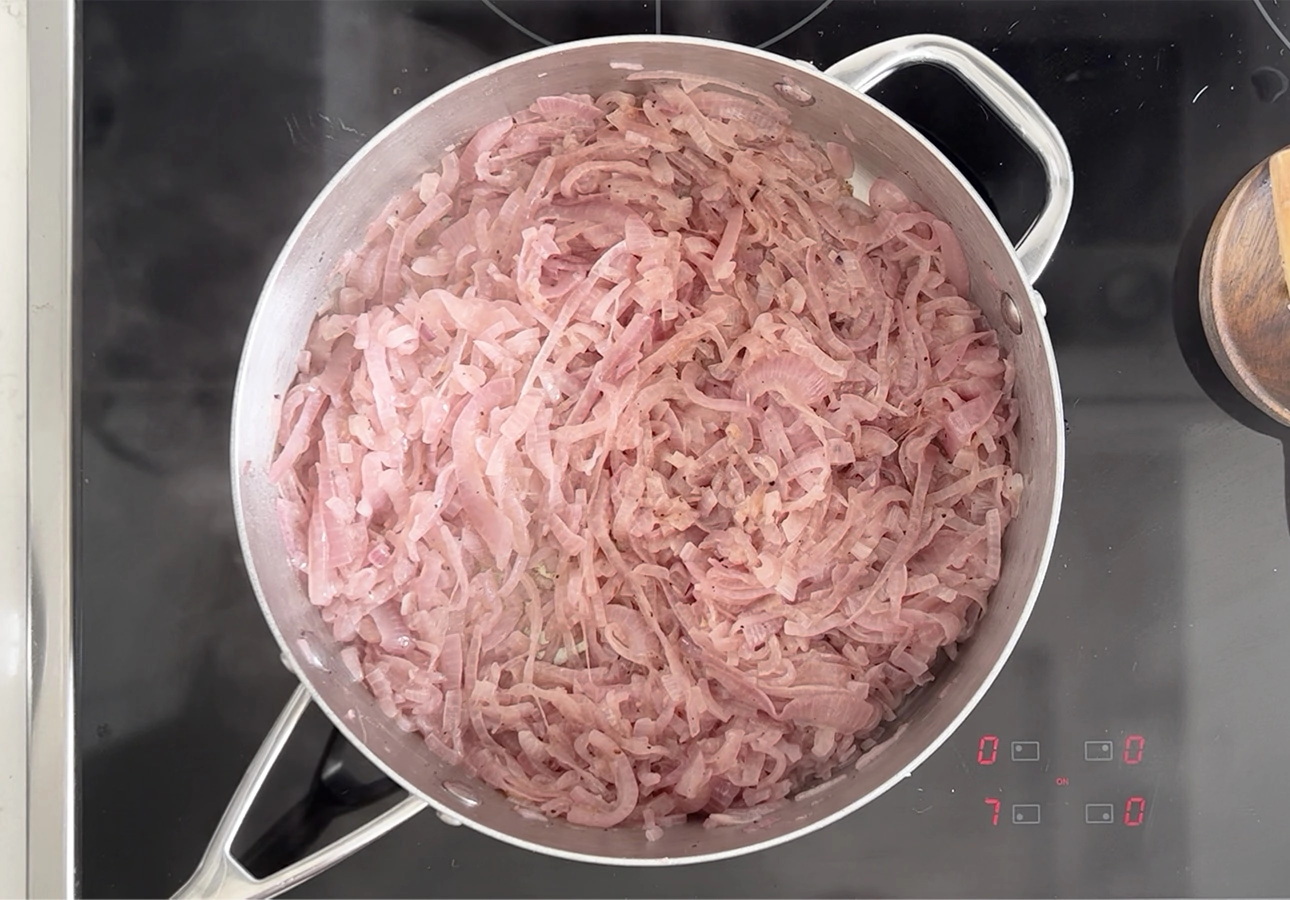
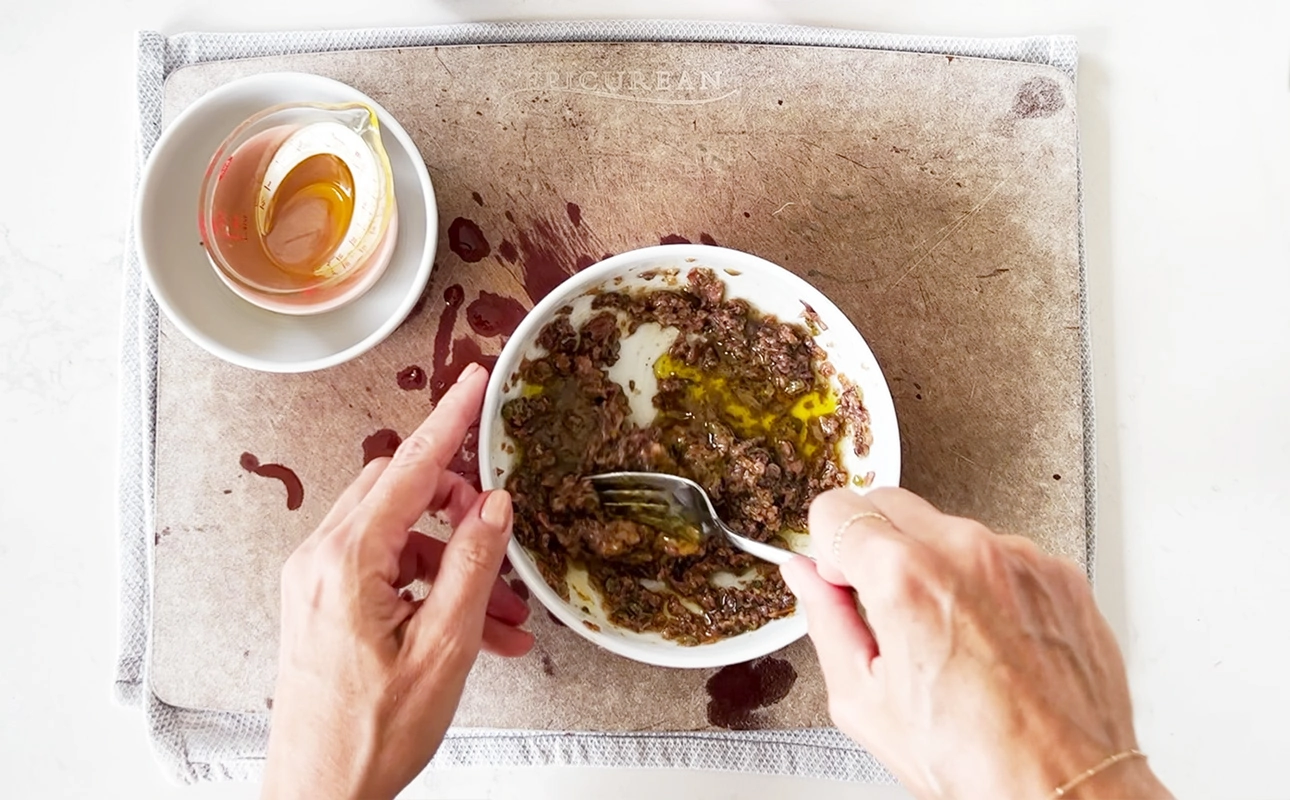
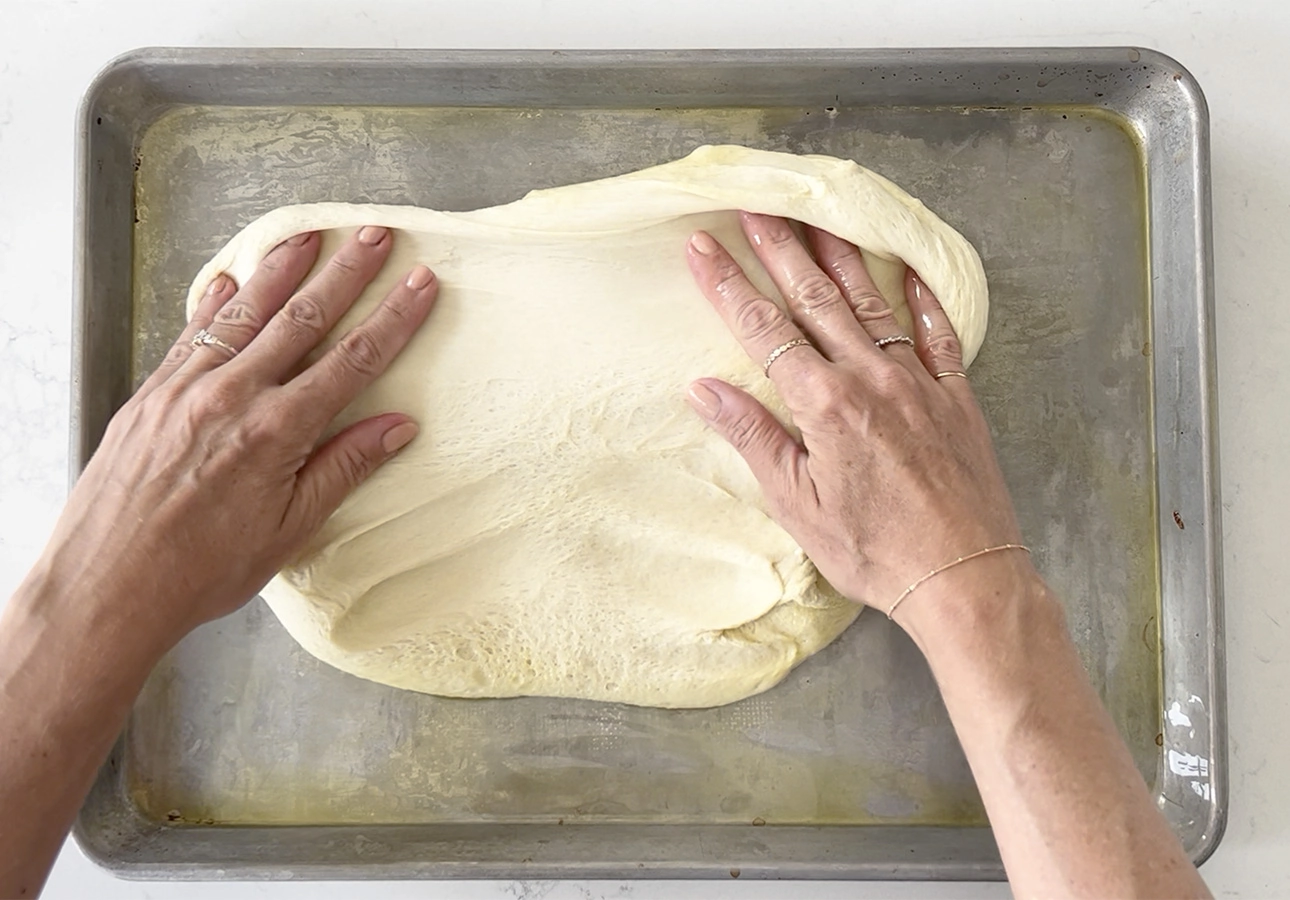

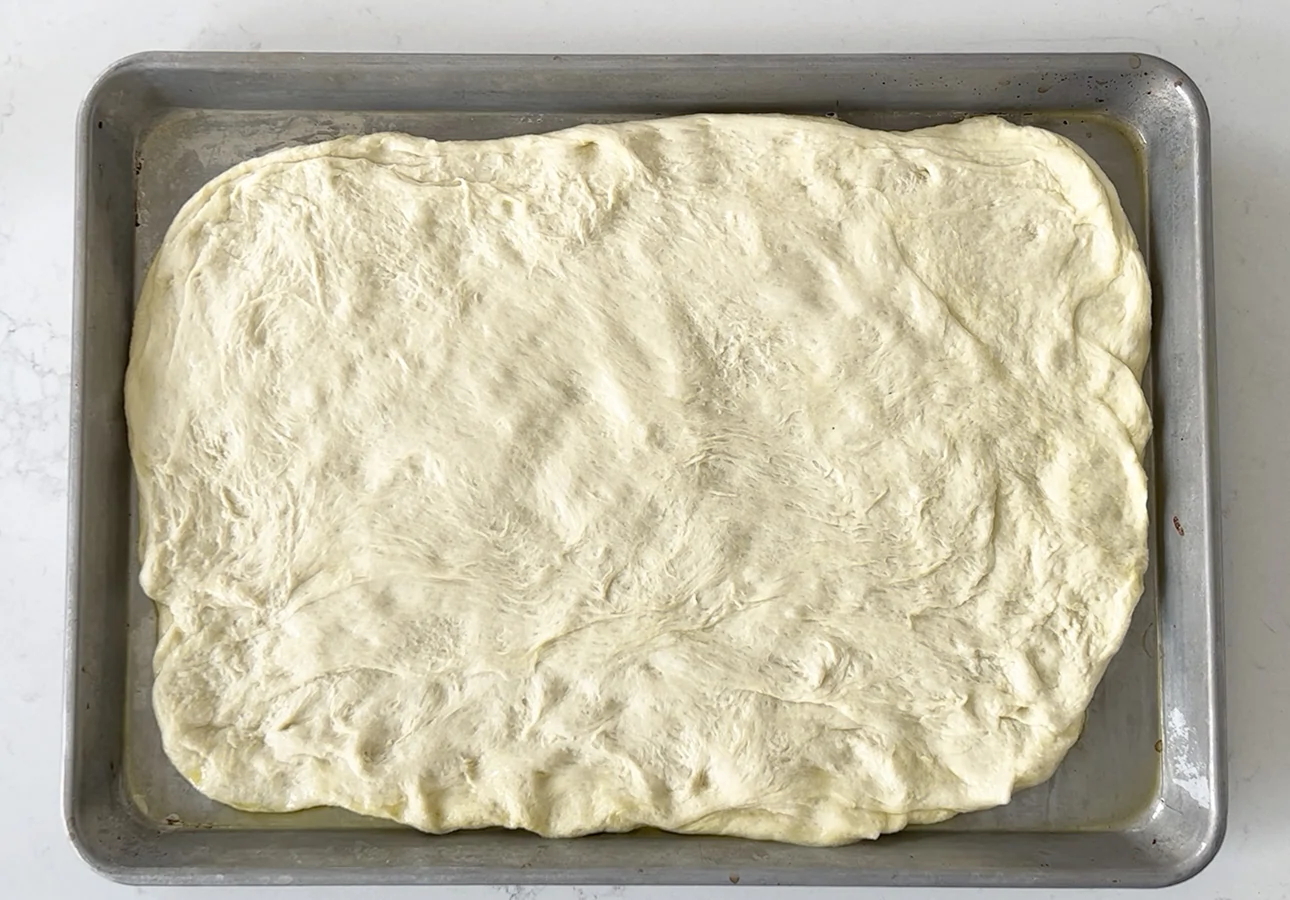
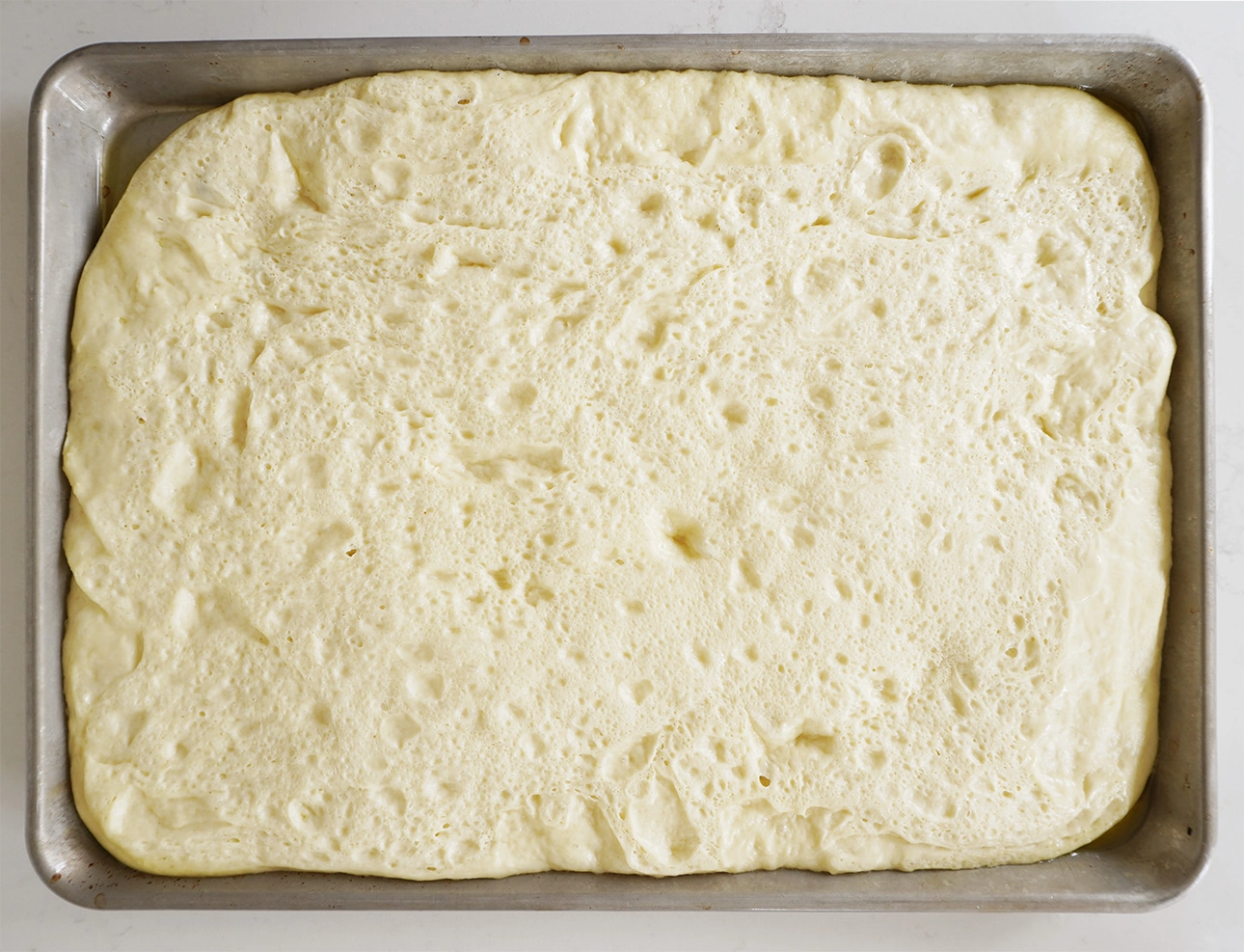
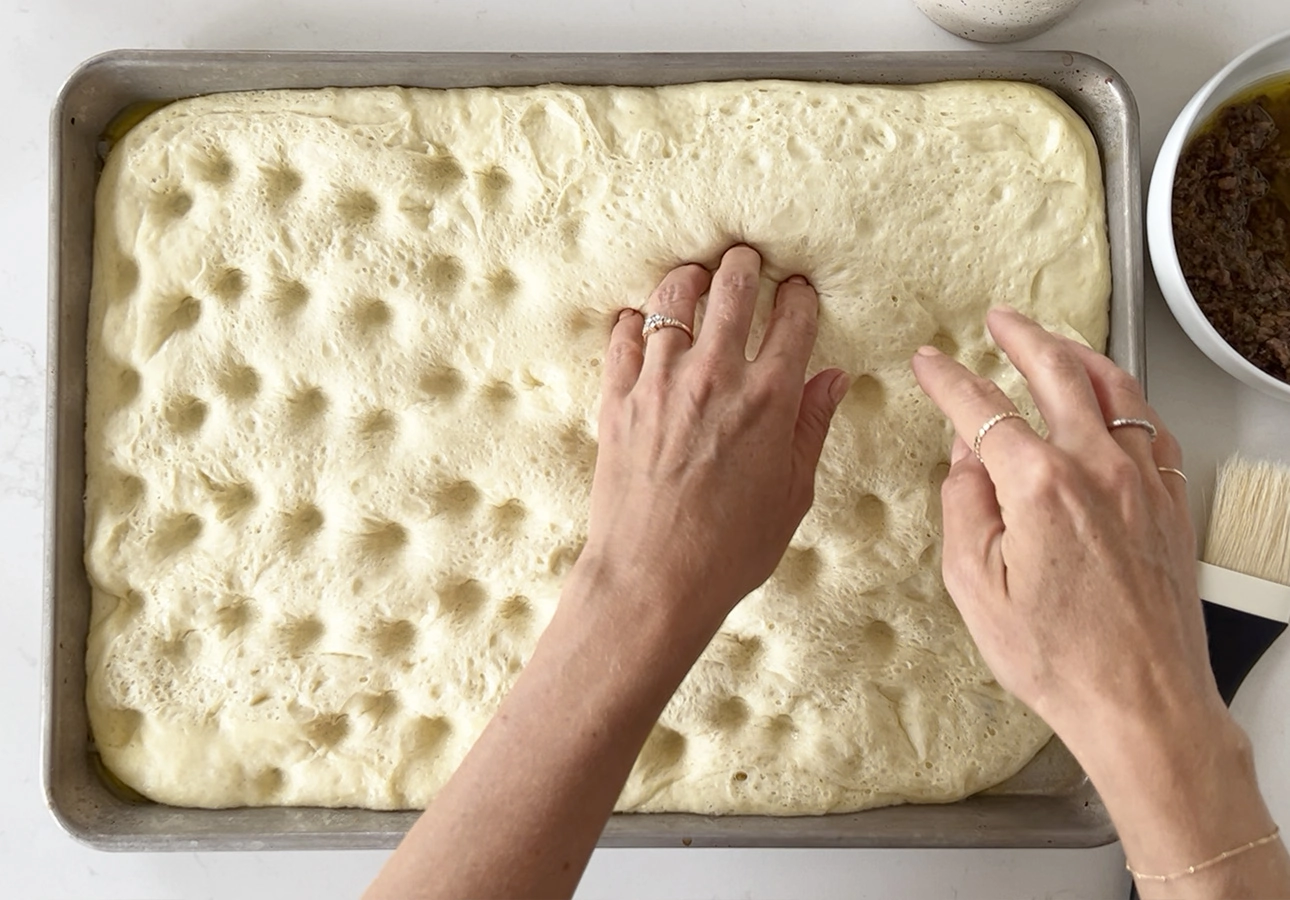
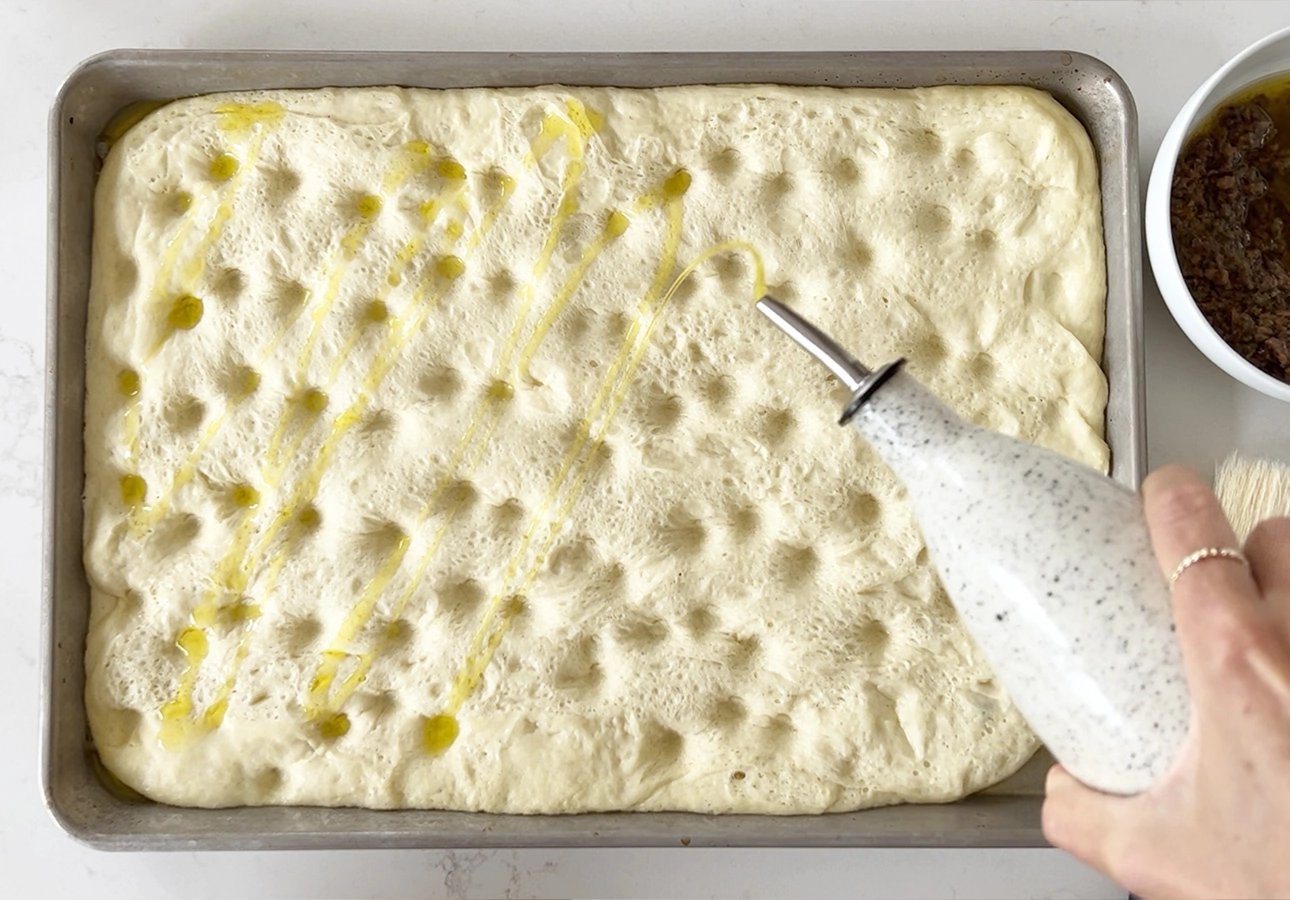
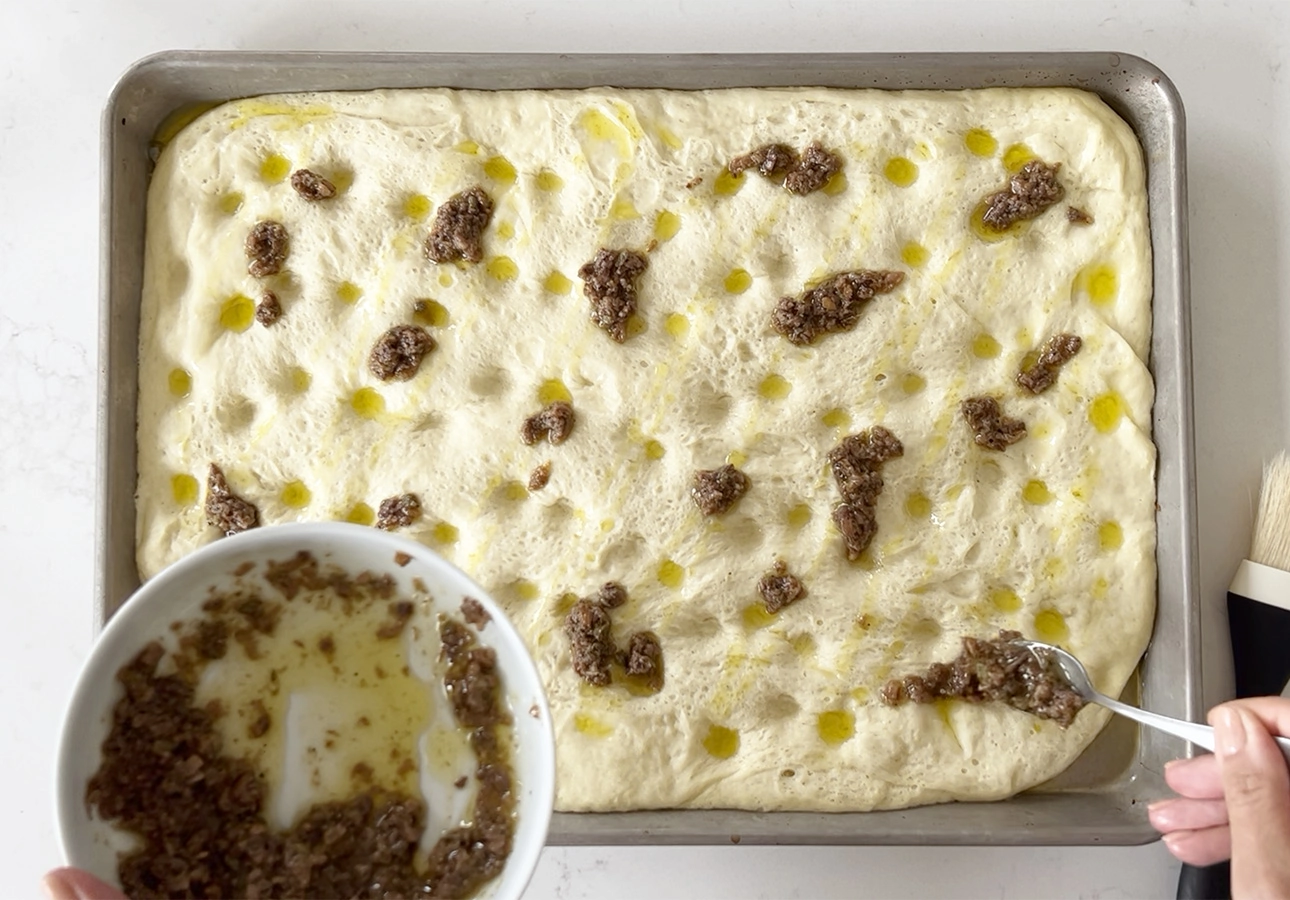
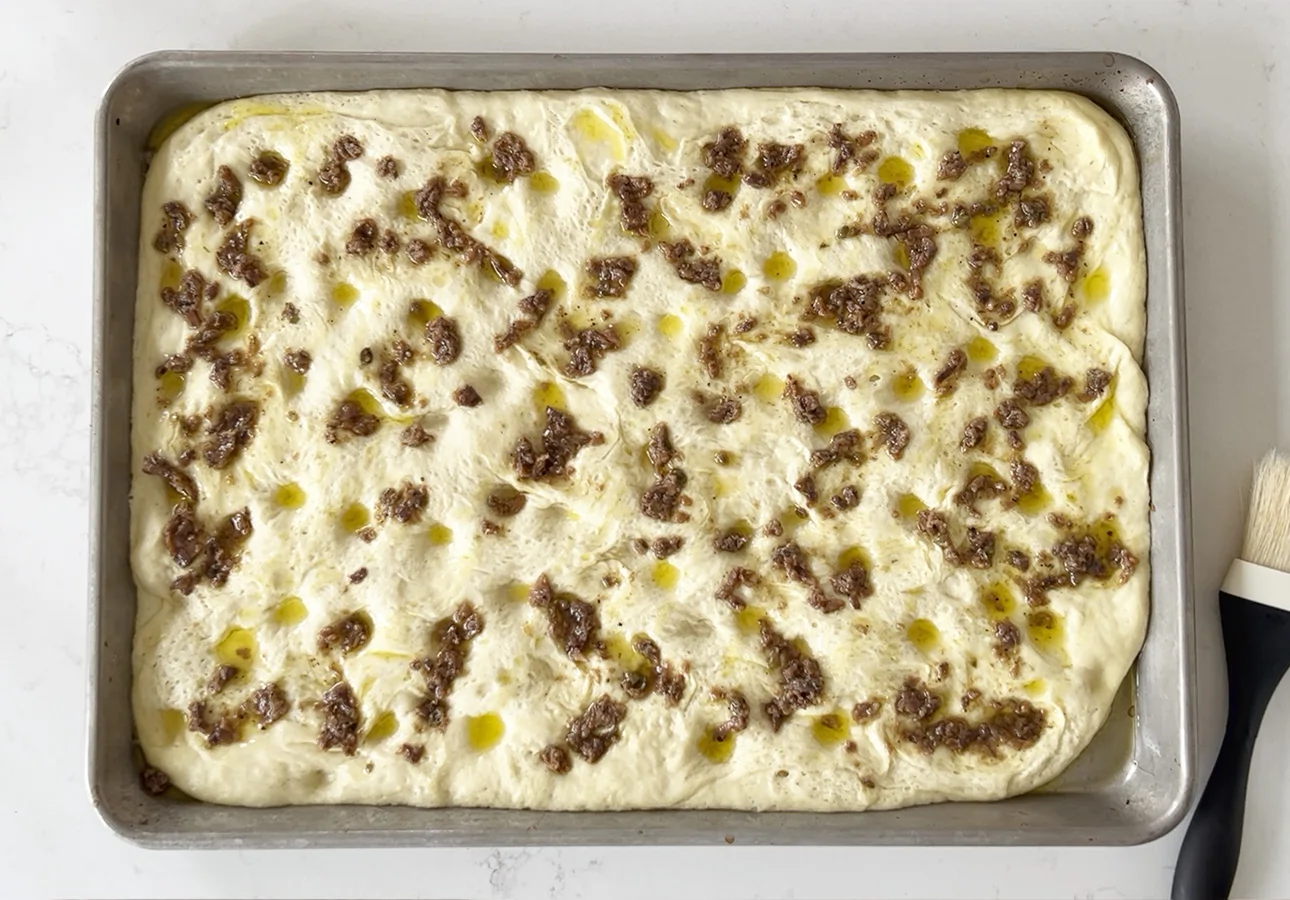
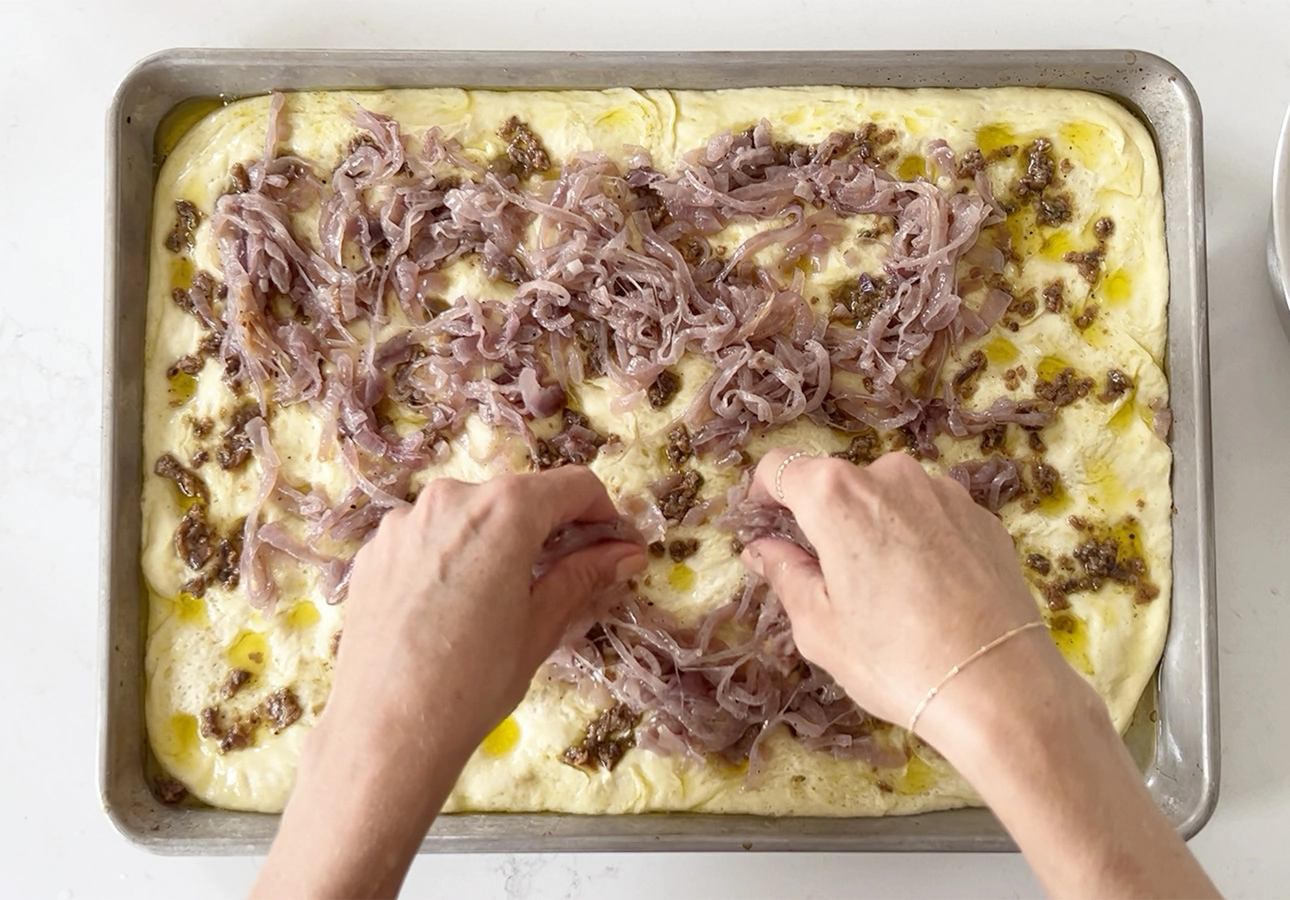
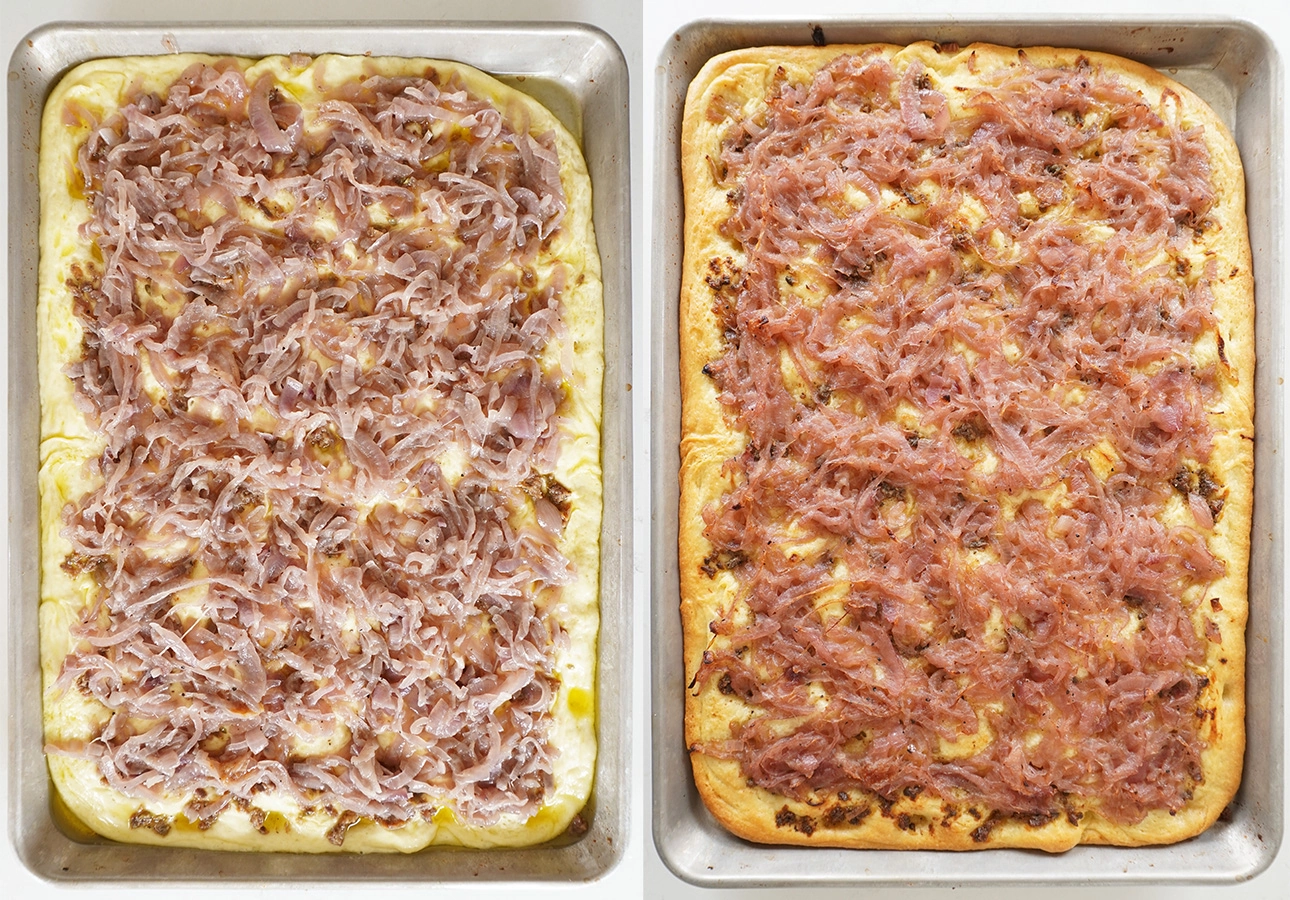
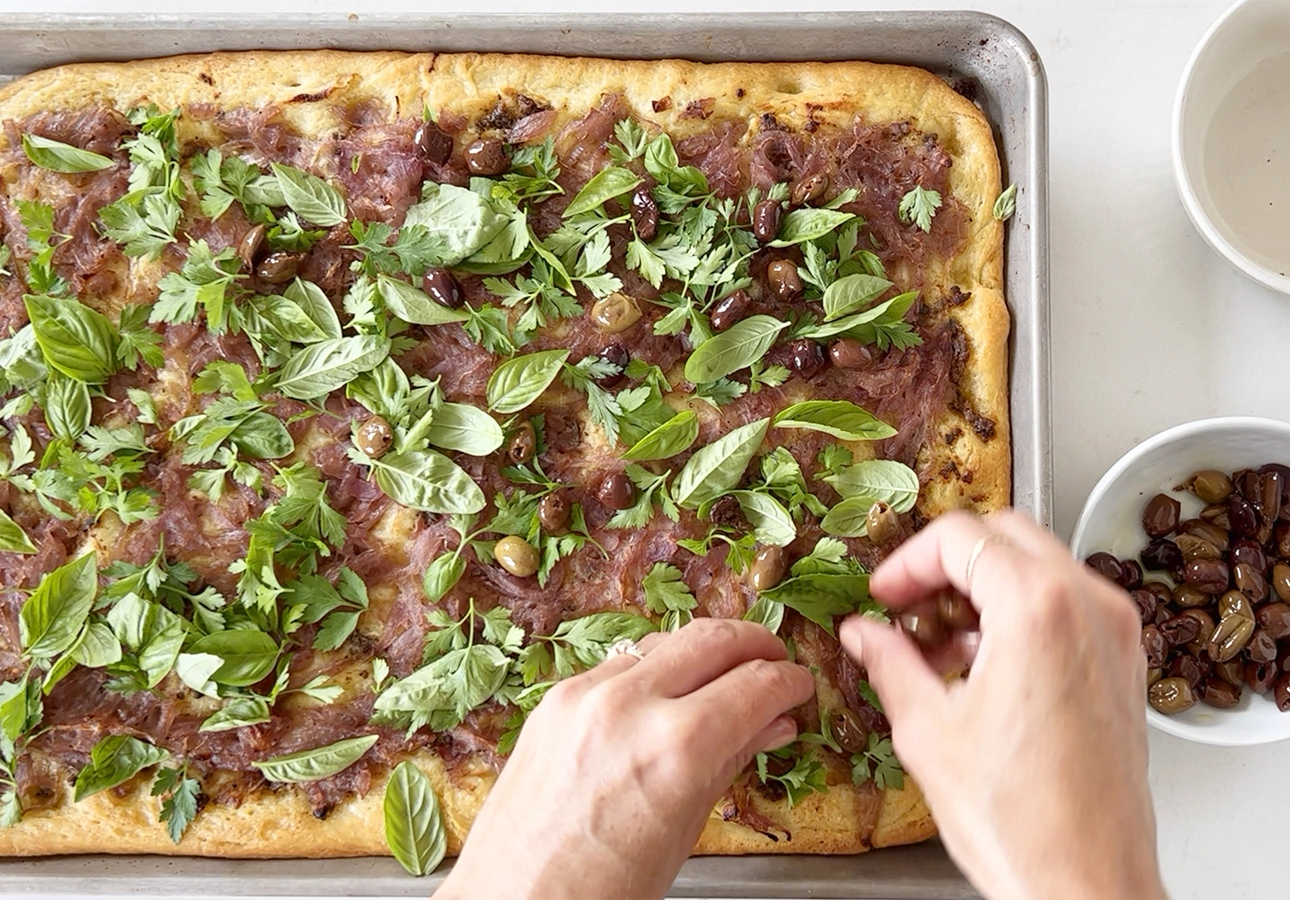
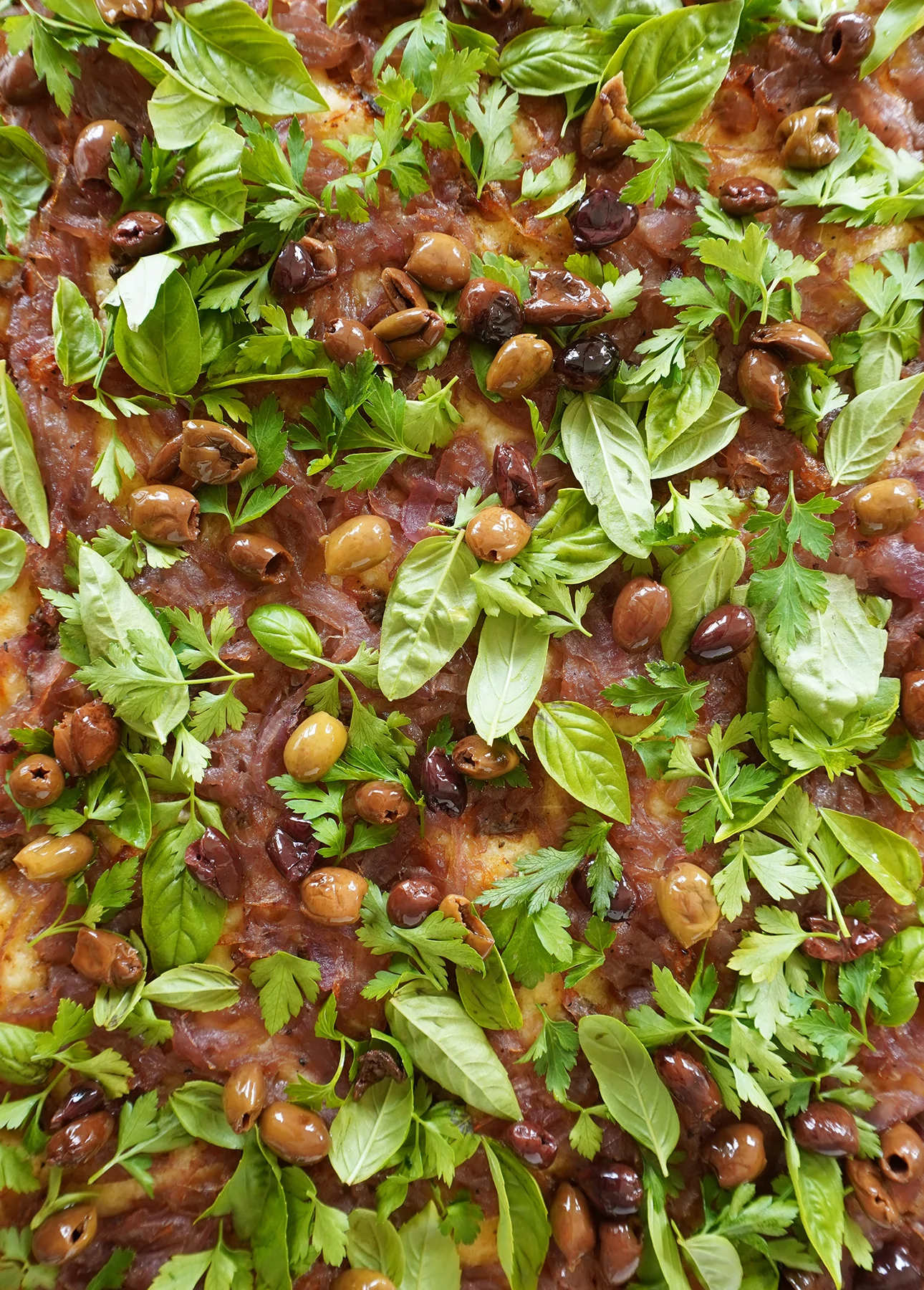

This recipe was just amazing, we made it last night and so so yummy. Really easy to follow and make. Thanks!
Happy you enjoyed this irresistible flatbread, Laura!
This flatbread was awesome! I agree with the whole olives thing. It just makes no sense. I’m so glad I tried it! Will make again.
Who wants to break a tooth biting into an olive pit, right? Happy you enjoyed the pissaladière, Erin!
Apero is a lifestyle, and this pissaladiere is a real taste of France! Thank you for all the tips.
Thanks for writing Helene! Happy you enjoyed the post and this irresistible recipe.
I love the combo on the onions and anchovies. It’s that savoury, briny flavor and it’s so good! This looks delicious :D
Anchovies quite simply have no substitutes! The flavor is so rich, it adds a lot of interest to this recipe.
Super tasty. I was nervous about the anchovies but I wanted to make a unique flatbread and this was the recipe I wanted to try. We really enjoyed the flavors in this one.
Happy you loved this pissaladière Amanda! I think anchovies are worth a try. This recipe is making the most of their irresistible flavor!
This is such a great-looking bread with overloaded stuff with it! Totally looks so delicious and yummy! I’ll definitely make this at home!
You’re going to love it Jamie! It’s a crowd-pleaser, too.
This is the most savory snack I have had in some time. Would make a great appetizer as well, thanks!
Pissaladière is an easy way to feed a crowd for happy house! So delicious!
Love this pizza/flatbread. Simple but so tasty! We all loved it and I wish I had made more.
Thanks Megane!
Never tried but it looks delicious and looks so easy to make.
I will prepare this for everyone. Thank you!
I think pissaladière would make a fun appetizer for the holidays! It would for sure get conversations going 🤗
Love a homemade flatbread! And anything with caramelized onions is right up my alley. Can’t wait to try!
The caramelized onions definitely make the dish here. And the aromatic kick from the anchovies, too!